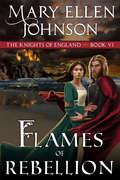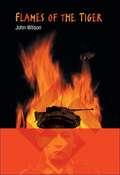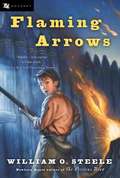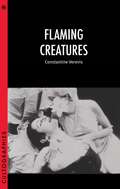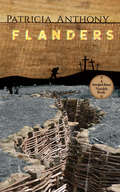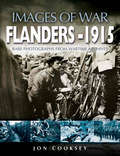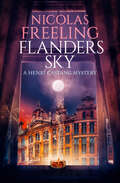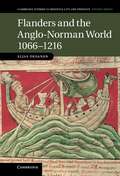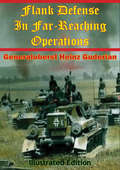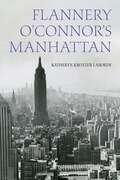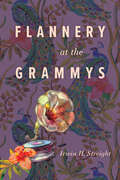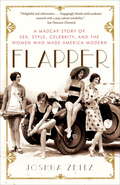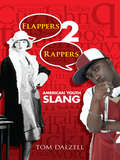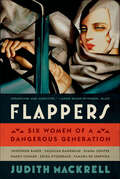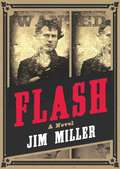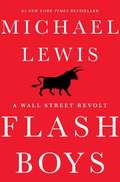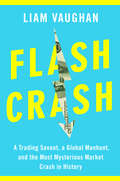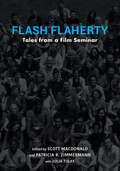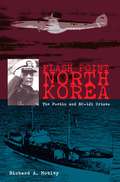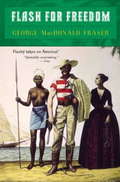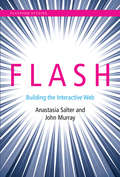- Table View
- List View
Flames of Discontent: The 1916 Minnesota Iron Ore Strike
by Gary KaunonenOn June 2, 1916, forty mostly immigrant mineworkers at the St. James Mine in Aurora, Minnesota, walked off the job. This seemingly small labor disturbance would mushroom into one of the region&’s, if not the nation&’s, most contentious and significant battles between organized labor and management in the early twentieth century. Flames of Discontent tells the story of this pivotal moment and what it meant for workers and immigrants, mining and labor relations in Minnesota and beyond.Drawing on previously untapped accounts from immigrant press newspapers, company letters, personal journals, and oral histories, historian Gary Kaunonen gives voice to the strike&’s organizers and working-class participants. In depth and in dramatic detail, his book describes the events leading up to the strike, and the violence that made it one of the most contentious in Minnesota history. Against the background of the physical and cultural landscape of Minnesota&’s Iron Range, Kaunonen&’s history brings the lives of working-class Finnish immigrants into sharp relief, documenting the conditions and circumstances behind the emergence of leftist politics and union organization in their ranks. At the same time, it shows how the region&’s South Slavic immigrants went from &“scabs&” during a 1907 strike to full-fledged striking members of the labor revolt of 1916. A look at the media of the time reveals how the three main contenders for working-class allegiances—mine owners, Progressive reformers, and a revolutionary union—communicated with their mostly immigrant audience. Meanwhile, documents from mining company officials provide a strong argument for corruption reaching as far as the state&’s then governor, Joseph A. A. Burnquist, whose strike-busting was undertaken in the interests of billion dollar corporations.Ultimately, anti-syndicalist laws were put in place to thwart the growing influence of organizations that sought to represent immigrant workers. Flames of Discontent raises the voices of those workers, and of history, against an injustice that reverberates to this day.
Flames of Rebellion: A Medieval Romance (The Knights of England Series #6)
by Mary Ellen JohnsonCivil War Once Again Threatens England in the Medieval Historical, THE FLAMES OF REBELLION, by Mary Ellen Johnson1397 to 1403. England, Tintagel, London, Shrewsbury, Conway Castle, Tower of London, Cumbria, Westminster Abbey, Wales and ScotlandIn the fourteenth century’s waning days, the tyrannical Richard II is knocked from his throne, and Henry IV is crowned, despite a shaky claim to the throne.Knight Matthew Hart, now in his sixties, believes he can retire to a quiet life in the wilds of Cumbria while Lancelot and Janey’s love remains more the stuff of Romances than reality.Yet, all too soon, England’s lords grow restless, betrayal is in the air, and Matthew and his family must again ride into battle on behalf of their endangered king.The fates of all the characters who grace the Knights of England series, spanning a century—including some of the most vivid battles, events and historical characters in medieval history—are resolved.Publisher’s Note: Readers with a passion for history will appreciate the author’s penchant for detail and accuracy. In keeping with the era, this story contains scenes of brutality which are true to the time and man’s timeless inhumanity. There are a limited number of sexual scenes and NO use of modern vulgarity.From the Author: There is nothing new under the sun. If we seek to understand today’s events, history will always provide the answer. By 1398 the megalomaniacal Richard II had consolidated his power, executed or banished all his enemies and destroyed all those who might speak out in opposition to him. Two years later Richard was deposed, thrown into a dungeon in Pontefract Castle and starved to death. Lessons: We can never predict the future; actions always have unintended consequences; we sow the seeds of our own destruction and payback’s a bitch!THE KNIGHTS OF ENGLAND, in series orderThe Lion and the LeopardA Knight There WasWithin A Forest DarkA Child Upon The ThroneLords Among the RuinsThe Flames of Rebellion
Flames of the Tiger
by John WilsonIn this novel by John Wilson, Dieter is seduced by the pomp and circumstance of war as a boy growing up during Hitler's rise to power. But as global hostilities intensify, Dieter is called upon to fight for his country in a conflict that he doesn't fully understand. With most of his family dead, Berlin in ruins and the Russian army closing in, Dieter can no longer naively cling to his childhood beliefs. The world he is facing is brutal, dirty and unforgiving, and the most he can hope for is the chance to survive.
Flaming Arrows
by William O. Steele"When hate comes in the gate, half the world ain't big enough." Once the big doors are barred, the settlers hiding in the wilderness fort are supposed to be safe from attack. Sure, the fort is small, food is scarce, and water is hard to come by. But the Chickamauga raiding parties are outside, the welcome faces of friends and neighbors are inside, and everyone is ready to band together against the ferocious Indian warriors until help arrives. Except that some of the settlers don't trust the Logan boys, whose father fights on the side of the Indians. And they don't trust Chad and his family, who have given protection to the Logans when the rest of the group would have cast them out to die. As the siege drags on, and hunger and thirst begin to take their toll, that mistrust becomes a fearful hatred that threatens to be the death of them all. AGES 8 AND UP
Flaming Creatures (Cultographies)
by Constantine VerevisBanned soon after its first midnight screenings, the prints seized and the organizers arrested, Jack Smith’s incendiary Flaming Creatures (1963) quickly became a cause célèbre of the New York underground. Championed and defended by Jonas Mekas and Susan Sontag, among others, the film wildly and gleefully transgresses nearly every norm of Hollywood morality and aesthetics. In a surreal and visually dense series of episodes, the titular “creatures” reenact scenes drawn from the collective cinematic unconscious, playing on mainstream film culture’s moral code in a way that is at once a love letter to classical Hollywood and a searing send-up of its absurdities.Tracing the film’s production and reception history, Constantine Verevis argues that it embodies a unique type of cinematic rewriting, one that combines Smith’s multifaceted artistic work with exotic fragments drawn from the cinematic past. This study of Smith’s magnum opus explores its status as a cult film that appropriates the visual texture, erotic nuance, and overt fabrication of old Hollywood exoticism.
Flanders
by Patricia Anthony"A harrowing and beautiful novel, demonstrating — again — that Patricia Anthony is one of our great writers." — Publishers WeeklyIn this gritty look at World War I's trench warfare, a young American sharpshooter ventures into no man's land each night to be ready by daybreak for the grim business of slaying record numbers of enemies. But Travis Lee Stanhope, a Texan serving with an English unit, is haunted by ghosts of the men he's killed as well as those of his fallen comrades. As he hovers on the brink of a transcendent experience, Travis gradually realizes that although he is surrounded by death, his true mission is related to life.A New York Times and American Library Association Notable Book, this tale was acclaimed by Booklist as "a haunting, sometimes almost hallucinatory, yet surprising war novel" and by Kirkus Reviews as "mesmerizing … highly textured and brimming with insight.""Flanders ranks close to All Quiet on the Western Front in its impact." — San Francisco Chronicle"Anthony's subtle and innovative storytelling reaches a new plane in her latest novel, a foray into magical realism that contrasts the waking hell of war with the fragile peace of eternity." — Library Journal
Flanders 1915: Rare Photographs From Wartime Archives (Images of War)
by Jon CookseyBy Christmas 1914 Britain's Regular Army had virtually ceased to exist. Four months of hard fighting had drained its manpower and the Territorial Army were called on to plug the gaps. The part-timers leapt at the chance to serve their country overseas and were soon on their way to the trenches and the harsh realities of war on the Western Front.Flanders 1915 tells the story, through rare and previously unpublished photographs and extended captions, of one of those eager Territorial battalions posted to Flanders during the first twelve months of WW1. It forms a unique and intimate record of the early years of war; many images captured on film by the private cameras of the battalion's junior officers, before official censorship was established. Above all it is a rare and outstanding portrait of the 'great adventure' of war in the days before Loos, the Somme and Passchendaele and the resulting lengthy casualty lists.
Flanders Sky (The Henri Castang Mysteries)
by Nicolas FreelingThe Edgar award–winning British crime writer’s latest Inspector Castang mystery “takes the international policier to high ground . . . and does the genre proud” (The New York Times).For Detective Castang, being asked to serve as an aid to a British jurist feels more like being fired than promoted, but relocating to Brussels with his wife is a nice perk. When his employer is charged with murder, Castang’s investigative skills are brought to the forefront once again. But the more he digs into the darkness, the more unsettled he becomes by the nature of evil, which appears to have no borders—and for which there is no true escape.“An insightful look at the human condition. Freeling is a treasure.” —Publishers Weekly“One of the better Castang tales, journeying into the maze of European politics, national characteristics, and combustible emotion. Thought-provoking and well told.” —Kirkus Reviews
Flanders and the Anglo-Norman World, 1066–1216
by Eljas OksanenThe union of Normandy and England in 1066 recast the political map of western Europe and marked the beginning of a new era in the region's international history. This book is a groundbreaking investigation of the relations and exchanges between the county of Flanders and the Anglo-Norman realm. Among other important themes, it examines Anglo-Flemish diplomatic treaties and fiefs, international aristocratic culture, the growth of overseas commerce, immigration into England and the construction of new social and national identities. The century and a half between the conquest of England by the duke of Normandy and the conquest of Normandy by the king of France witnessed major revolutions in European society, politics and culture. This study explores the history of England, northern France and southern Low Countries in relation to each other during this period, giving fresh perspectives to the historical development of north-western Europe in the Central Middle Ages.
Flank Defense In Far-Reaching Operations [Illustrated Edition]
by Generaloberst Heinz GuderianIncludes the World War Two On The Eastern Front (1941-1945) Illustration Pack - 198 photos/illustrations and 46 maps.Often written during imprisonment in Allied War camps by former German officers, with their memories of the World War fresh in their minds, The Foreign Military Studies series offers rare glimpses into the Third Reich. In this study the father of the Panzerarmeen, Generaloberst Heinz Guderian discusses how he and his tanks attained such success in Russia.Focussing on the Second Panzer Army's, which he commanded during 1941, General Guderian discusses the actions for the offensive over the Bug, the crossing of the Dnepr, the attack at Smolensk, the thrust at Kiev, the breakthrough at Orel-Bryansk and the operations around Tula.
Flannery O'Connor's Manhattan (Studies in the Catholic Imagination: The Flannery O'Connor Trust Series)
by Katheryn Krotzer LabordeThis book offers a unique twist to the Who’s Who of midcentury writers, editors, and artistsMuch is made of Flannery O’Connor’s life on the Georgia dairy farm, Andalusia—a rural setting that clearly influenced her writing. But before she lived on that farm, before she showed signs of having lupus, before she became dependent on her mother and then succumbed to the disease at thirty-nine, O’Connor lived in the northeast. She stayed at the artists’ colony Yaddo in 1948 and early 1949 and lived in Connecticut with good friends from fall of 1949 through all of 1950. But in between those experiences, and perhaps more importantly, O’Connor lived in Manhattan.In her biographies, little is said of her time in Gotham; in some sources, this period gets no more than one sentence. But little is said because little has been known. In Flannery O’Connor’s Manhattan, the author’s goal is to explore New York City from O’Connor’s point of view. To do this, the author consults not just letters (both unpublished and published) and biography, but five personal address books housed in Emory’s Stuart A. Rose Manuscript, Archives and, Rare Book Library. The result is a book of interest to both the O’Connor fan and the O’Connor scholar, not to mention those interested in midcentury Manhattan.Flannery O’Connor’s Manhattan is part guide to the who-was-who and who-lived-where of New York from roughly 1948 to 1964, at least those as they mattered to O’Connor. It also acts as a window to the writer’s experiences in the city, whether she was coming into town for a series of meetings or strolling down Broadway on her way to lunch. In the end, it is the combination of the who-she-knew and the what-she-did that formed O’Connor’s personal view of what is arguably the most famous of American cities.
Flannery at the Grammys
by Irwin H. StreightA devout Catholic, a visionary—and some say prophetic—writer, Flannery O’Connor (1925–1964) has gained a growing presence in contemporary popular culture. While O’Connor professed that she did not have an ear for music, allusions to her writing appear in the lyrics and narrative form of some of the most celebrated musicians on the contemporary music scene. Flannery at the Grammys sounds the extensive influence of this southern author on the art and vision of a suite of American and British singer-songwriters and pop groups. Author Irwin H. Streight invites critical awareness of O’Connor’s resonance in the products of popular music culture—in folk, blues, rock, gospel, punk, heavy metal, and indie pop songs by some of the most notable figures in the popular music business. Streight examines O'Connor's influence on the art and vision of multiple Grammy Award winners Bruce Springsteen, Lucinda Williams, R.E.M., and U2, along with celebrated songwriters Nick Cave, PJ Harvey, Sufjan Stevens, Mary Gauthier, Tom Waits, and others. Despite her orthodox religious, and at times controversial, views and limited literary output, O’Connor has left a curiously indelible mark on the careers of the successful musicians discussed in this volume. Still, her acknowledged influence and remarkable presence in contemporary pop and rock songs has not been well noted by pop music critics and/or literary scholars. Many years in the making, Flannery at the Grammys achieves groundbreaking work in cultural studies and combines in-depth literary and pop music scholarship to engage the informed devotee and the casual reader alike.
Flapper
by Joshua ZeitzBlithely flinging aside the Victorian manners that kept her disapproving mother corseted, the New Woman of the 1920s puffed cigarettes, snuck gin, hiked her hemlines, danced the Charleston, and necked in roadsters. More important, she earned her own keep, controlled her own destiny, and secured liberties that modern women take for granted. Her newfound freedom heralded a radical change in American culture.Whisking us from the Alabama country club where Zelda Sayre first caught the eye of F. Scott Fitzgerald to Muncie, Indiana, where would-be flappers begged their mothers for silk stockings, to the Manhattan speakeasies where patrons partied till daybreak, historian Joshua Zeitz brings the era to exhilarating life. This is the story of America's first sexual revolution, its first merchants of cool, its first celebrities, and its most sparkling advertisement for the right to pursue happiness.The men and women who made the flapper were a diverse lot. There was Coco Chanel, the French orphan who redefined the feminine form and silhouette, helping to free women from the torturous corsets and crinolines that had served as tools of social control. Three thousand miles away, Lois Long, the daughter of a Connecticut clergyman, christened herself "Lipstick" and gave New Yorker readers a thrilling entrée into Manhattan's extravagant Jazz Age nightlife.In California, where orange groves gave way to studio lots and fairytale mansions, three of America's first celebrities--Clara Bow, Colleen Moore, and Louise Brooks, Hollywood's great flapper triumvirate--fired the imaginations of millions of filmgoers.Dallas-born fashion artist Gordon Conway and Utah-born cartoonist John Held crafted magazine covers that captured the electricity of the social revolution sweeping the United States.Bruce Barton and Edward Bernays, pioneers of advertising and public relations, taught big business how to harness the dreams and anxieties of a newly industrial America--and a nation of consumers was born.Towering above all were Zelda and Scott Fitzgerald, whose swift ascent and spectacular fall embodied the glamour and excess of the era that would come to an abrupt end on Black Tuesday, when the stock market collapsed and rendered the age of abundance and frivolity instantly obsolete.With its heady cocktail of storytelling and big ideas, Flapper is a dazzling look at the women who launched the first truly modern decade.From the Hardcover edition.
Flapper
by Joshua ZeitzBlithely flinging aside the Victorian manners that kept her disapproving mother corseted, the New Woman of the 1920s puffed cigarettes, snuck gin, hiked her hemlines, danced the Charleston, and necked in roadsters. More important, she earned her own keep, controlled her own destiny, and secured liberties that modern women take for granted. Her newfound freedom heralded a radical change in American culture.Whisking us from the Alabama country club where Zelda Sayre first caught the eye of F. Scott Fitzgerald to Muncie, Indiana, where would-be flappers begged their mothers for silk stockings, to the Manhattan speakeasies where patrons partied till daybreak, historian Joshua Zeitz brings the era to exhilarating life. This is the story of America's first sexual revolution, its first merchants of cool, its first celebrities, and its most sparkling advertisement for the right to pursue happiness.The men and women who made the flapper were a diverse lot. There was Coco Chanel, the French orphan who redefined the feminine form and silhouette, helping to free women from the torturous corsets and crinolines that had served as tools of social control. Three thousand miles away, Lois Long, the daughter of a Connecticut clergyman, christened herself "Lipstick" and gave New Yorker readers a thrilling entrée into Manhattan's extravagant Jazz Age nightlife.In California, where orange groves gave way to studio lots and fairytale mansions, three of America's first celebrities--Clara Bow, Colleen Moore, and Louise Brooks, Hollywood's great flapper triumvirate--fired the imaginations of millions of filmgoers.Dallas-born fashion artist Gordon Conway and Utah-born cartoonist John Held crafted magazine covers that captured the electricity of the social revolution sweeping the United States.Bruce Barton and Edward Bernays, pioneers of advertising and public relations, taught big business how to harness the dreams and anxieties of a newly industrial America--and a nation of consumers was born.Towering above all were Zelda and Scott Fitzgerald, whose swift ascent and spectacular fall embodied the glamour and excess of the era that would come to an abrupt end on Black Tuesday, when the stock market collapsed and rendered the age of abundance and frivolity instantly obsolete.With its heady cocktail of storytelling and big ideas, Flapper is a dazzling look at the women who launched the first truly modern decade.From the Hardcover edition.
Flapper
by Joshua ZeitzBlithely flinging aside the Victorian manners that kept her disapproving mother corseted, the New Woman of the 1920s puffed cigarettes, snuck gin, hiked her hemlines, danced the Charleston, and necked in roadsters. More important, she earned her own keep, controlled her own destiny, and secured liberties that modern women take for granted. Her newfound freedom heralded a radical change in American culture.Whisking us from the Alabama country club where Zelda Sayre first caught the eye of F. Scott Fitzgerald to Muncie, Indiana, where would-be flappers begged their mothers for silk stockings, to the Manhattan speakeasies where patrons partied till daybreak, historian Joshua Zeitz brings the era to exhilarating life. This is the story of America's first sexual revolution, its first merchants of cool, its first celebrities, and its most sparkling advertisement for the right to pursue happiness.The men and women who made the flapper were a diverse lot. There was Coco Chanel, the French orphan who redefined the feminine form and silhouette, helping to free women from the torturous corsets and crinolines that had served as tools of social control. Three thousand miles away, Lois Long, the daughter of a Connecticut clergyman, christened herself "Lipstick" and gave New Yorker readers a thrilling entrée into Manhattan's extravagant Jazz Age nightlife.In California, where orange groves gave way to studio lots and fairytale mansions, three of America's first celebrities--Clara Bow, Colleen Moore, and Louise Brooks, Hollywood's great flapper triumvirate--fired the imaginations of millions of filmgoers.Dallas-born fashion artist Gordon Conway and Utah-born cartoonist John Held crafted magazine covers that captured the electricity of the social revolution sweeping the United States.Bruce Barton and Edward Bernays, pioneers of advertising and public relations, taught big business how to harness the dreams and anxieties of a newly industrial America--and a nation of consumers was born.Towering above all were Zelda and Scott Fitzgerald, whose swift ascent and spectacular fall embodied the glamour and excess of the era that would come to an abrupt end on Black Tuesday, when the stock market collapsed and rendered the age of abundance and frivolity instantly obsolete.With its heady cocktail of storytelling and big ideas, Flapper is a dazzling look at the women who launched the first truly modern decade.From the Hardcover edition.
Flapper: A Madcap Story of Sex, Style, Celebrity, and the Women Who Made America Modern
by Joshua ZeitzBlithely flinging aside the Victorian manners that kept her disapproving mother corseted, the New Woman of the 1920s puffed cigarettes, snuck gin, hiked her hemlines, danced the Charleston, and necked in roadsters. More important, she earned her own keep, controlled her own destiny, and secured liberties that modern women take for granted. Her newfound freedom heralded a radical change in American culture. Whisking us from the Alabama country club where Zelda Sayre first caught the eye of F. Scott Fitzgerald to Muncie, Indiana, where would-be flappers begged their mothers for silk stockings, to the Manhattan speakeasies where patrons partied till daybreak, historian Joshua Zeitz brings the era to exhilarating life. This is the story of America's first sexual revolution, its first merchants of cool, its first celebrities, and its most sparkling advertisement for the right to pursue happiness. The men and women who made the flapper were a diverse lot. There was Coco Chanel, the French orphan who redefined the feminine form and silhouette, helping to free women from the torturous corsets and crinolines that had served as tools of social control. Three thousand miles away, Lois Long, the daughter of a Connecticut clergyman, christened herself "Lipstick" and gave New Yorker readers a thrilling entrée into Manhattan's extravagant Jazz Age nightlife. In California, where orange groves gave way to studio lots and fairytale mansions, three of America's first celebrities--Clara Bow, Colleen Moore, and Louise Brooks, Hollywood's great flapper triumvirate--fired the imaginations of millions of filmgoers. Dallas-born fashion artist Gordon Conway and Utah-born cartoonist John Held crafted magazine covers that captured the electricity of the social revolution sweeping the United States. Bruce Barton and Edward Bernays, pioneers of advertising and public relations, taught big business how to harness the dreams and anxieties of a newly industrial America--and a nation of consumers was born. Towering above all were Zelda and Scott Fitzgerald, whose swift ascent and spectacular fall embodied the glamour and excess of the era that would come to an abrupt end on Black Tuesday, when the stock market collapsed and rendered the age of abundance and frivolity instantly obsolete. With its heady cocktail of storytelling and big ideas,Flapperis a dazzling look at the women who launched the first truly modern decade. From the Hardcover edition.
Flappers 2 Rappers: American Youth Slang
by Tom DalzellThis entertaining, highly readable book pulses with the vernacular of young Americans, tracing slang terms and expressions from the end of the nineteenth century to the present. In addition to alphabetical listings for each decade, it features fascinating word histories and sidebars about language and culture—jazz cat jive, the argot of Beat poets, gritty inner-city street talk, and other captivating colloquialisms.A master storyteller and wordsmith, Tom Dalzell is the author of The Concise New Partridge Dictionary of Slang and Unconventional English and The Routledge Dictionary of Modern American Slang and Unconventional English. In Flappers 2 Rappers, he presents more than just lists of words. His introductions to each chronological chapter offer fascinating insights into the ways in which slang reflects the era's historical mood and significance. Great for browsing, this unique reference will delight students of history as well as word and language enthusiasts.
Flappers: Six Women of a Dangerous Generation
by Judith MackrellBy the 1920s, women were on the verge of something huge. Jazz, racy fashions, eyebrowraising new attitudes about art and sex—all of this pointed to a sleek, modern world, one that could shake off the grimness of the Great War and stride into the future in one deft, stylized gesture. The women who defined this the Jazz Age—Josephine Baker, Tallulah Bankhead, Diana Cooper, Nancy Cunard, Zelda Fitzgerald, and Tamara de Lempicka—would presage the sexual revolution by nearly half a century and would shape the role of women for generations to come.In Flappers, the acclaimed biographer Judith Mackrell renders these women with all the color that marked their lives and their era. Both sensuous and sympathetic, her admiring biography lays bare the private lives of her heroines, filling in the bold contours. These women came from vastly different backgrounds, but all ended up passing through Paris, the mecca of the avant-garde. Before she was the toast of Parisian society, Josephine Baker was a poor black girl from the slums of Saint Louis. Tamara de Lempicka fled the Russian Revolution only to struggle to scrape together a life for herself and her family. A committed painter, her portraits were indicative of the age's art deco sensibility and sexual daring. The Brits in the group—Nancy Cunard and Diana Cooper— came from pinkie-raising aristocratic families but soon descended into the salacious delights of the vanguard. Tallulah Bankhead and Zelda Fitzgerald were two Alabama girls driven across the Atlantic by a thirst for adventure and artistic validation.But beneath the flamboyance and excess of the Roaring Twenties lay age-old prejudices about gender, race, and sexuality. These flappers weren't just dancing and carousing; they were fighting for recognition and dignity in a male-dominated world. They were more than mere lovers or muses to the modernist masters—in their pursuit of fame and intense experience, we see a generation of women taking bold steps toward something burgeoning, undefined, maybe dangerous: a New Woman.
Flash
by Jim Miller"'This remarkable novel is nothing less than a secret history of southern California-a radical past that might yet redeem our future."-Mike Davis, author of City of QuartzA chance encounter with a faded "Wanted!" poster in a San Diego library sends journalist Jack Wilson on a wild adventure through southern California's radical past. As Jack searches for the truth about I.W.W. outlaw Bobby Flash, he uncovers a hidden history of real-life revolutionaries . . . and learns a powerful lesson about the importance of family in the process.Jim Miller is a labor educator and activist in San Diego, California.
Flash Boys: A Wall Street Revolt
by Michael LewisFour years after his #1 bestseller The Big Short, Michael Lewis returns to Wall Street to report on a high-tech predator stalking the equity markets.<P> Flash Boys is about a small group of Wall Street guys who figure out that the U.S. stock market has been rigged for the benefit of insiders and that, post–financial crisis, the markets have become not more free but less, and more controlled by the big Wall Street banks. Working at different firms, they come to this realization separately; but after they discover one another, the flash boys band together and set out to reform the financial markets. This they do by creating an exchange in which high-frequency trading—source of the most intractable problems—will have no advantage whatsoever.<P> The characters in Flash Boys are fabulous, each completely different from what you think of when you think “Wall Street guy.” Several have walked away from jobs in the financial sector that paid them millions of dollars a year. From their new vantage point they investigate the big banks, the world’s stock exchanges, and high-frequency trading firms as they have never been investigated, and expose the many strange new ways that Wall Street generates profits.<P> The light that Lewis shines into the darkest corners of the financial world may not be good for your blood pressure, because if you have any contact with the market, even a retirement account, this story is happening to you. But in the end, Flash Boys is an uplifting read. Here are people who have somehow preserved a moral sense in an environment where you don’t get paid for that; they have perceived an institutionalized injustice and are willing to go to war to fix it.
Flash Crash: A Trading Savant, a Global Manhunt, and the Most Mysterious Market Crash in History
by Liam VaughanThe riveting story of a trading prodigy who amassed $70 million from his childhood bedroom--until the government accused him of helping trigger an unprecedented market collapse *Soon to be a feature film starring Dev Patel*On May 6, 2010, financial markets around the world tumbled simultaneously and without warning. In the span of five minutes, a trillion dollars of valuation was lost. The Flash Crash, as it became known, represented the fastest drop in market history. When share values rebounded less than half an hour later, experts around the globe were left perplexed. What had they just witnessed?Navinder Singh Sarao hardly seemed like a man who would shake the world's financial markets to their core. Raised in a working-class neighborhood in West London, Nav was a preternaturally gifted trader who played the markets like a computer game. By the age of thirty, he had left behind London's "trading arcades," working instead out of his childhood home. For years the money poured in. But when lightning-fast electronic traders infiltrated markets and started eating into his profits, Nav built a system of his own to fight back. It worked--until 2015, when the FBI arrived at his door. Depending on whom you ask, Sarao was a scourge, a symbol of a financial system run horribly amok, or a folk hero who took on the tyranny of Wall Street and the high-frequency traders.A real-life financial thriller, Flash Crash uncovers the remarkable, behind-the-scenes narrative of a mystifying market crash, a globe-spanning investigation into international fraud, and the man at the center of them both.
Flash Flaherty: Tales from a Film Seminar
by Julia TulkeFlash Flaherty, the much-anticipated follow-up volume to The Flaherty: Decades in the Cause of Independent Cinema, offers a people's history of the world-renowned Robert Flaherty Film Seminar, an annual event where participants confront and reimagine the creative process surrounding multiple document/documentary forms and modes of the moving image.This collection, which includes a mosaic of personal recollections from attendees of the Flaherty Seminar over a span of more than 60 years, highlights many facets of the "Flaherty experience." The memories of the seminarians reveal how this independent film and media seminar has created a lively and sometimes cantankerous community within and beyond the institutionalized realm of American media culture. Editors Scott MacDonald and Patricia R. Zimmermann have curated a collective polyphonic account that moves freely between funny anecdotes, poetic impressions, critical considerations, poignant recollections, scholarly observations, and artistic insights. Together, the contributors to Flash Flaherty exemplify how the Flaherty Seminar propels shared insights, challenging debates, and actual change in the world of independent media.
Flash Point North Korea
by Richard MobleyDuring a dark period of U.S. military history in the late 1960s, North Korean forces captured an American naval vessel and shot down an unarmed reconnaissance aircraft, taking the lives of thirty-one U.S. sailors and Marines and striking a damaging blow to American honor. This look back to that earlier time of crisis provides serious food for thought as contemporary strategists again grapple with a North Korean regime that threatens regional security and U.S. national interests. The capture of USS Pueblo has been written about extensively but rarely in context with the shoot down four months later of an EC-121 aircraft and never with so much relevant documentation Richard Mobley, a veteran naval intelligence officer who served on the staff of U.S. forces in Korea during the late 1990s--confronting many of the same challenges faced in the 1960s and today--has uncovered a vast array of recently declassified documents that shed new light on these events and address lingering questions about U.S. reactions and its failure to retaliate. The formerly top secret answers to these and many other frequently asked questions are all covered in Mobley's groundbreaking investigation. His careful examination of the resource strains caused by concurrent U.S. involvement in Vietnam the unexecuted retaliatory plans, and lessons learned confirms many criticisms long leveled at U.S. planners and decision-makers. It also challenges other criticisms by revealing new information and by placing these facts in the context of the time. The author couples the wisdom of hindsight with the revelation of new information for a timely new work on a subject of ongoing and vital importance.
Flash for Freedom!: Flashman And The Mountain Of Light, Flash For Freedom!, Flashman And The Redskins (Flashman #No. 3)
by George Macdonald FraserA game of cards leads Flashman from the jungle death-house of Dahomey to the slave state of Mississippi as he dabbles in the slave trade in Volume III of the "Flashman Papers". When Flashman was inveigled into a game of pontoon with Disraeli and Lord George Bentinck, he was making an unconscious choice about his own future - would it lie in the House of Commons or the West African slave trade? Was there, for that matter, very much difference? Once again Flashman's charm, cowardice, treachery, lechery and fleetness of foot see the lovable rogue triumph by the skin of his chattering teeth.
Flash: Building the Interactive Web (Platform Studies)
by John Murray Anastasia SalterHow Flash rose and fell as the world's most ubiquitous yet divisive software platform, enabling the development and distribution of a world of creative content.Adobe Flash began as a simple animation tool and grew into a multimedia platform that offered a generation of creators and innovators an astonishing range of opportunities to develop and distribute new kinds of digital content. For the better part of a decade, Flash was the de facto standard for dynamic online media, empowering amateur and professional developers to shape the future of the interactive Web. In this book, Anastasia Salter and John Murray trace the evolution of Flash into one of the engines of participatory culture. Salter and Murray investigate Flash as both a fundamental force that shaped perceptions of the web and a key technology that enabled innovative interactive experiences and new forms of gaming. They examine a series of works that exemplify Flash's role in shaping the experience and expectations of web multimedia. Topics include Flash as a platform for developing animation (and the “Flashimation” aesthetic); its capacities for scripting and interactive design; games and genres enabled by the reconstruction of the browser as a games portal; forms and genres of media art that use Flash; and Flash's stance on openness and standards—including its platform-defining battle over the ability to participate in Apple's own proprietary platforms. Flash's exit from the mobile environment in 2011 led some to declare that Flash was dead. But, as Salter and Murray show, not only does Flash live, but its role as a definitive cross-platform tool continues to influence web experience.

